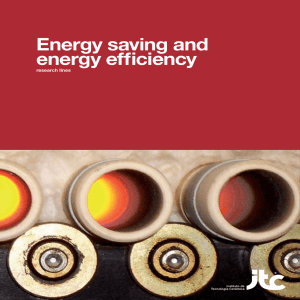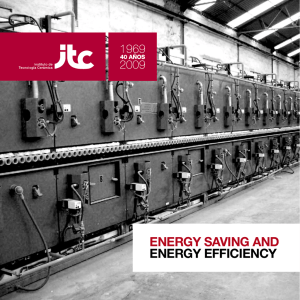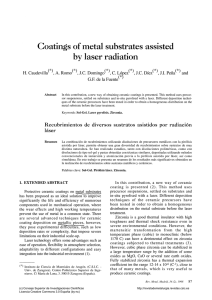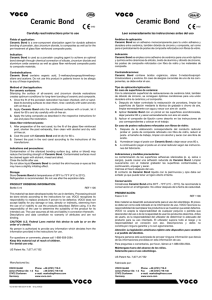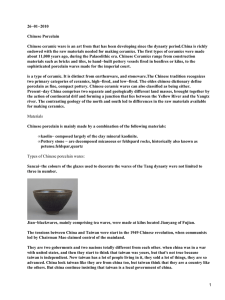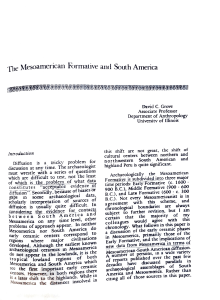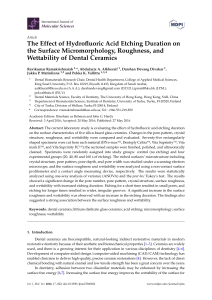Joining oxide ceramics
Anuncio
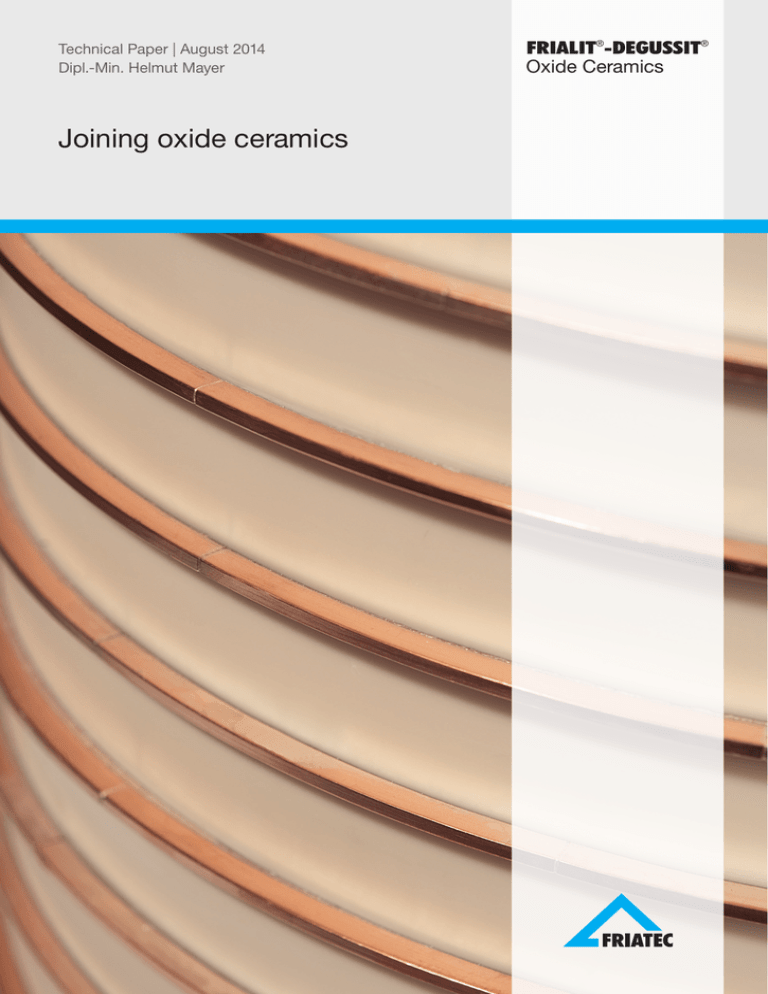
w Technical Paper | August 2014 Dipl.-Min. Helmut Mayer Joining oxide ceramics FRIALIT®-DEGUSSIT® Oxide Ceramics 1. Introduction As high-performance ceramics, products made from oxideceramic materials such as Al2O3 and ZrO2 generally have to meet complex requirements, usually in a central function of technical constructions. For the optimal utilization of of these materials properties , it is generally necessary to combine them to other metallic or ceramic components by means of a friction-, form- or material- locked joint [1,2]. Fig. 1 shows a selection of common joining methods after [3] for such ceramicmetal joints (CMJ) and ceramic-ceramic joints (CCJ). The key factor for the selection of an appropriate joining method and therefore for the manufacturing costs is the technical requirements profile that demands from the joined products a reliable function, sometimes in extreme application conditions and often for over a decade. There follows a description of selected joining methods and design principles that the FRIALIT – DEGUSSIT Division of FRIATEC AG has applied for more than three decades in the solution of complex technical problems. Joining techniques Mechanically geometric Screwing / riveting Binding Sealing Reactive Shrinking Sintering Brazing Metal Glueing Glas Welding Laser Rub Organic Conventional Active Inorganic Diffusion Fig.: 1 Joining methods for ceramic-ceramic and ceramic-metal joints 2. Joining Methods 2.1 Friction- and Form-Locked Methods These methods, e.g. shrunk ceramic-metal joints, are applied whenever possible as, with comparatively low technical expense, they are able to achieve high reliability in the application conditions. By placing in ductile with the insertion of ductile intermediate layers between the ceramic and metal, vacuum-tight joints can be realized in individual cases. The basic principles of the shrinkage method are explained in [4]. As a typical example, Fig. 2 shows a die made of Mg-PSZ (FRIALIT FZM) shrunk into steel. According to internal studies, to squeeze out a ceramic with 19 mm diameter and 17 mm length shrunk into a steel tube, a force of at least 25 kN would be needed at room temperature. Fig. 2: FRIALIT FZM ring shrunk into steel FRIALIT®-DEGUSSIT® Oxide Ceramics - Joining oxide ceramics 2 2.2 Firmly Bonded Methods 2.2.1 Glueing with Organic Adhesives This joining technique is used predominantly for applications requiring high joint strength at application temperatures in the region of 150°C and in which shrunk joints, for instance, cannot be realized. By the use of special duroplastic adhesives in combination with an adhesionrelated design, the tensile strength of such joints reaches at least 50 MPa at room temperature. A typical product produced with the adhesion method is the plunger made from Al2O3 ceramic FRIALIT F99.7 in combination with stainless steel. Fig. 3: Glued joint consisting of a FRIALIT F99.7-plunger with stainless steel 2.2.2 Brazing with Glass Brazes A key criterion for this joining method is the use of glass brazes with a thermal expansion adapted to the ceramic as glasses do not have any metallic ductile properties. With CCJs, strengths of 100 MPa can be easily reached at room temperature. Fig. 4 shows by way of example a measurement cell made of Al2O3 for absolute pressure, which operates according to the capacitive measurement principle in the pressure range to 2.6 bar. In the temperature range from – 40 to + 95°C, this system reaches a hysteresis error of the measurement signal of less than 0.05 %. The maximum application temperature of glass-brazed CCJ is limited to 1100°C in air with the current technology. One example of a design for use at this temperature level is shown in Fig. 5. Fig. 4: Glass-brazed pressure measurement cell Fig. 5: Glass-brazed tubestructure made from FRIALIT F99.7 FRIALIT®-DEGUSSIT® Oxide Ceramics - Joining oxide ceramics 3 2.2.3 Brazing with Metallic brazer For complex applications in electrical engineering equipment and plants, which often specify for the CMJ used a combination of high insulating power of the ceramic material, high vacuum tightness and high mechanical strength at temperatures even above 500°C, joints of Al2O3 ceramic with various types of metal have now been established for decades. The Classical production technology for electrical feedthroughs and insulating components with these properties is based on the molybdenummanganese method, which was developed in the first half of the last century [5]. The starting point for this process is a powder blend of molybdenum, manganese and silicate additives that are rendered into a paste form with the addition of an organic binder. With appropriate adjustment of its viscosity, this paste can be applied to the Al2O3 substrate by painting, screen or pad printing, spraying, pouring or dipping. During the subsequent firing process above 1200°C in a reducing atmosphere, a low-temperature melting silicate phase that reacts with the ceramic is formed. At the same time the molybdenum forms a porous sintered layer. The silicate melt penetrates into the pore volume of this layer. During cooling from the firing temperature, the melt hardens and the result is a material-locked base layer on the surface of the ceramic [6-8]. As the majority of commercially available flux-free vacuum brazes do not sufficiently wet this layer, F99.7 Joint zone Hard solder 1.3917 Fig 6: Cross section through MoMn-metallized FRIALIT F.99, soldered with 1.3917 it is generally galvanically or autocatalytically einforced by 2...5 μm with nickel or copper. This prepared coating can be brazed to the intended metal parts in a reducing atmosphere or in a vacuum with sufficiently low residual pressure. The braze material used as standard is the eutectic AgCu28. Fig. 6 shows the cross-section through an FRIALIT F99.7 ceramic, which has been brased with the material 1.3917 by means of the method described. In the tensile test after [9], this material combination achieves strength values exceeding 200 MPa. If the application has higher requirements with regard to the application temperature, the behaviour in corrosive conditions and the use of metals that are hardly wetted by AgCu28, brazematerials are used that are suitable for these conditions (see the large column on the right of Table 1). For around 25 years solder materials have been known that, thanks to a content of < 5 % of an active element like e.g. Ti or Zr, enable the direct soldering of Al2O3 and ZrO2 ceramic with a metal component without the need for a base metallization. Brazing with such active brazing is only effective in inert gas atmospheres or in a vacuum, as otherwise, owing to the reaction of the active metal with the furnace atmosphere, the ceramic partner is not sufficiently wetted by the braze. Material of Metal Part Braze Material Material No. Symbol Type Solidus (°C) Liquidus (°C) - ST37 SnAg4 221 221 1.4301 X 5 CrNi 18 10 AgCu28 779 779 1.4541 X 6 CrNi Ti 18 10 AgCu26, 6Pd5 807 810 1.4571 X 6 CrNiMoTi 17 12 2 AgCu21Pd25 901 950 1.3917 Ni 42 AuNi18 950 950 1.3981 NiCo 29 18 CuGe10 900 1000 1.3982 NiCo 28 23 AuCu65 1000 1020 2.0040 OF - Cu AgCu26, 5Ti 780 805 2.0070 SE - Cu 2.4610 Hastelloy C4 - CuNi44 - Cu Sn5 Pure metals (> 99%) Ti, Nb, Mo, Ni, Pt, Cu (OF, SE), Ag Tab 1: Materials of metal components and metallic brazes (selected) FRIALIT®-DEGUSSIT® Oxide Ceramics - Joining oxide ceramics 4 The strength values of actively brazed composites match the level of hardsoldered pre-metallized components [10,11]. Active brazes, however, cannot be as widely used as the standard vacuum brazes of classical MoMn systems because they tend to remain in the braze depot during the soldering process. To reach a leakage rate < 10-9 mbar · l/s for He in CMCs, the brazing brazing conditions must be more carefully controlled to avoid extreme brittle phase formation. For the brazing of Mg-PSZ, active brazing is necessary as the fusion penetration temperature of the MoMn metallization lies in a range that can lead to thermally induced phase transformation of the material and therefore to its destruction. 2.2.4 Co-Firing and Diffusion Welding The co-firing method is, for example, used for the production of measurement cells for magnetic-inductive flowmeters [12]. In this case, a Pt-cermet electrode is joined with the ceramic to ensure high vacuum tightness. With a pressure of 60 bar applied to the inside of the tube, tubular measurement cells made of FRIALIT FZM with centrally arranged cermet electrodes reach leakage rates < 10-10 mbar*l/s for He. To burst the version shown in Fig. 7, a pressure >1000 bar would be necessary. Parts burst in such tests show no predominant fracture in the cermet region, thereby indicating the low-stress conditions prevailing there. Sometimes for pure ceramic components, structures are required which, on account of their high degree of complexity, can only be made with relatively complex and expensive methods. If exclusively material of the same type is required, only diffusion welding remains as an option for a practicable material-locked process for joining the components. The pump impeller made from FRIALIT F99.7 shown in Fig. 8 must be made with this method. Fig. 7: Measurement cell from FRIALIT FZM for magnetic-inductive flow measurement-sintered cermet, Fig. 8: Pump impeller from FRIALIT F99.7 FRIALIT®-DEGUSSIT® Oxide Ceramics - Joining oxide ceramics 5 3. Design This section refers mainly to brazed CMJ for applications in electronics and electrical engineering as in such designs often a combination of different materials and structures must be realized, whereby the products must satisfy a general requirement for high vacuum tightness and high mechanical and thermal strength. 3.1 Thermal Fit of the Joint Partners Coeffiicient of linear thermal expansion (α) For the reliable joining of ceramic with metallic materials, the degree to which the thermal expansion as well as the elastic and plastic behaviour of the partners to be joined agree is crucial. By way of example, Fig. 9 shows the coefficients of linear thermal expansion of various metals as a function of the temperature compared to ceramic consisting of Al2O3 and Mg-PSZ. The figure shows that especially in hightemperature processes the different thermal expansion of the joining partners must, by means of the appropriate design or sufficient elastic and plastic deformation of at least one of the two joint partners, minimize the residual stress in the joined zone to ensure the reliable function of the component overall. An extreme example is shown in Fig. 10. The figure shows a segment of a pipe with rectangular exterior and approximately oval interior contour. Such pipes are used, for example, in accelerator systems of large research institutes, the special geometry of the ceramic being dictated by the surrounding magnets. As the requirements profile only permit metals with diamagnetic properties, Al2O3 ceramic and austenitic steel were defined for the basic design. On account of the reduced geometric symmetry, the large differences in the low ductility of the steel, it could be expected that the direct soldering of the ceramic with the steel would not result in a joint with high vacuum tightness. To minimize the residual stresses in the joining zone, a ductile intermediate layer made of copper was placed in, and to check the thermal load capacity of the brazed type unit, a plate of the same time of material was welded onto the steel ring. The part brazed in two stages (the first stage involving brazing of the copper with 1.4571 and the second stage, at a lower temperature, the brazing of this pre-stage with the metallized ceramic) reached a leakage rate < 10-10 mbar · l/s for He in the tightness test. From the deformation of the copper by around 1 mm per side lengthways in the joint zone, it can be seen that the mechanical stresses imposed there during cooling from the brazing temperature have been sufficiently reduced by plastic flow. 25 20 15 10 5 0 100200300400500600700800 Temperature (°C) Al2O3 Mg-PSZ 1.3917 1.4571 1.3981 2.0040 Fig. 9: Thermal expansion of various oxide ceramic and metallic materials as a function of temperature FRIALIT®-DEGUSSIT® Oxide Ceramics - Joining oxide ceramics Fig. 10: Brazed joint of FRIALIT F99.7, copper and 1.4571 6 3.2 Types of Design With the design of CMJ and CCJ, the designer takes on the responsible job of, on the one hand, supplying the customer with a product that can reliably meet the requirements, while, on the other hand, ensuring that this product can be manufactured at reasonable cost. This means in detail: WW Realization of the required properties profile with the simplest possible solutions and standardized prefabricated products. WW Ceramic-oriented design. WW Production-oriented design. Function-oriented selection of the materials requires an extremely detailed knowledge of the requirements profile for the product. The design of the joint constructions is then oriented to the geometric possibilities, the installation conditions, the usable materials and their thermal fit. Fig. 11 shows some basic types of composite structures regularly realized by soldering for joining oxide ceramics. internal and external brazing front-edge brazing A selection of commonly used metallic materials is shown in Tab. 1. Where possible, the composite is designed so that once soldered, the metal part imposes mainly compressive loads on the ceramic as ceramic materials reach their highest strength values when subjected to this type of load. Particular scope for design is given by metals with high ductility, which, like copper, with appropriate design, enable the production of high-vacuum tight, rotationally symmetrical parts with a well over 250 mm diameter. Fig. 12 shows some typical examples of brazed, high-vacuum-tight products which are now used mainly in those fields of electrical engineering and electronics with high requirements for vacuum tightness, thermomechanical properties and capacity to withstand pressure, temperature and often corrosive attack. internal and external brazing flat brazing external brazing with offset flange flat brazing with compensation ring Fig. 11: Basic types of ceramic-metal joints FRIALIT®-DEGUSSIT® Oxide Ceramics - Joining oxide ceramics 7 4. Product examples Below some typical examples of brazed, high-vacuumtight products which are now used mainly in those fields of electrical engineering and electronics with high requirements Electrical Engineering WW Single terminal and multiterminal feedthroughs WW High pressure feedthroughs for onshore/offshore technology WW Isolating tubes for fluids, gases and ultra-high vacuum WW Standoffs WW Insulating parts for accelerator technology WW Insulating parts for sensor technology Measurement and control technology WW Cable end plugs for thermocouples and heating elements WW Pressure-sealed feedthrouhgs for flow and filling-level measurement WW Housing for magnetic positioner sensor WW Sensor components for pressure, temperature, oxygen content WW Deflection and focusing components for electron microscopes for vacuum tightness, thermomechanical properties and capacity to withstand pressure, temperature and often corrosive attack. Accelerator technology Dipole, kicker and quadrupole chambers for beam deflection and focusing WW Coupling windows for high frequency WW Insulators and accelerators for high voltage applications WW Metalized ceramics for stochastic beam cooling WW Vacuum technology WW UHV-tight feedthroughs for different voltages and currents WW Insulators and insulating tubes fot construction WW Ceramic breaks for vacuum systems WW Filament holder Medical technology WW Rotating X-ray tube for computed tomography WW Image intensifier for radiology WW Components for electron sources WW Insulators for X-rays References [1] Nicholas, M.G.: Joining of Ceramics. Chapman and Hall, London, New York, Tokyo, Melbourne, Madras (1990), 215 S. [2]Informationszentrum Technische Keramik: Brevier Technische Keramik. Fahner Verlag, Lauf (2003) [3] Lugscheider, E., Krappitz, H., Boretius, M.: Fügen von Hochleistungskeramik untereinander und mit Metall. Techni- sche Mitteilungen 80 (1987) 231 –237 [4] DIN 7190. Beuth Verlag, Berlin (1988). [5] Pulfrich, H.: Ceramic – to – Metal Seal. US Pat. No. 2,163,407 (1939) [6] Meyer, A.: Zum Haftmechanismus von Molybdän/ Mangan- Metallisierungs- schichten auf Korundkeramik. Ber. DKG 42 (1965), 405 – 444, 452 – 454 [7] Helgesson, C. J.: Ceramic – to – Metal Bonding. Technical Publishers Inc. Cambridge, Mass. (1968) [8] Twentyman, M. E.: High – Temperatu- re Metallizing. Parts 1 – 3. J. Mater. Sci. 10 (1975) 765 – 798 [9] Merkblatt DVS 3101-1. Mechanische Prüfung von Keramik-Metall-Verbindungen. Bestimmung der Haftfestigkeit von hartlötfähig metallisierter Keramik durch Zugprüfung. DVS-Verlag Düsseldorf (1999) [10] Turwitt, M.: Bending Test for Active Brazed Metal/ Ceramic Joints – A Round Robin. cfiI Ber. DKG 71 (1994) 406 – 410 [11] Boretius, M.: Aktivlöten von Hochleis- tungskeramiken und Vergleich mit konventionellen Lötverfahren. TechnischWissenschaftliche Berichte der RWTH Aachen. Nr. 33 (1991), 186 S. [12] Mayer, H., Stevens, U.: Thermomechanisch robust Oxidkeramische Präzisionsmesszellen für die magnetisch-induktive Durchflussmessung. Prozessautomation & Messtechnik 4 (2006) 26 – 31 FRIALIT®-DEGUSSIT® Oxide Ceramics - Joining oxide ceramics 8 FRIATEC Aktiengesellschaft Ceramics Division Steinzeugstraße 50 68229 Mannheim, Germany Tel: +49 621 486-1378 Fax: +49 621 486-1605 [email protected] www.friatec.de
